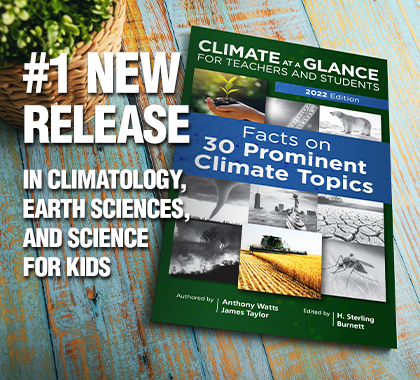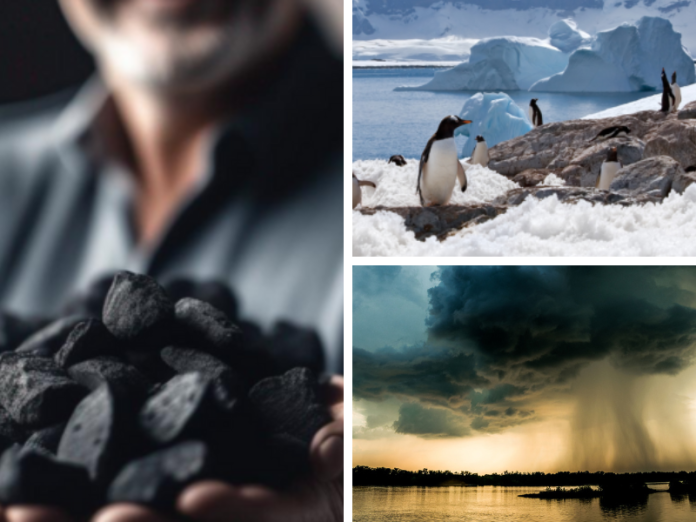YOU SHOULD SUBSCRIBE TO CLIMATE CHANGE WEEKLY.
IN THIS ISSUE:
- Fossil Fuels Aren’t Going Away Soon
- Podcast of the Week: The Truth About Electric Vehicles and a High Carbon Lifestyle (Guest: The Hon. Jason Isaac)
- West Antarctica Is Cooling, Its Climate Dominated by Ocean Currents
- Flood Losses Are Declining as a Percentage of GDP
- Climate Comedy
- Video of the Week: National Climate Report #5: The Good, The Bad, and the Ugly
- Recommended Sites
Miss Anything at Heartland’s Climate Conference? No Problem.

Fossil Fuels Aren’t Going Away Soon

Evidence is mounting that the demise of fossil fuels, much ballyhooed by climate alarmists, is still a long way off and is in fact fading in the distance. This means the goal of net zero by 2030, 2035, or even 2050 is increasingly likely to be nothing more than a pipedream. Of course, if the alarmists are right and carbon dioxide emissions are boosting temperatures, the failure to reach net zero will cause the world to breach the purportedly dangerous 1.5 or even 2.0 degree rise above preindustrial global average temperatures.
If you believe this means disaster, buy the bunker or cemetery plot of your choice now.
A friend and colleague, Duggan Flanakin, recently detailed how Germany is walking back its commitments to end coal use. Germany is opening new coal fields and reopening previously shuttered coal-fueled power plants in response to power shortfalls and rising prices caused by the massive shift to unreliables—er, I mean renewables. Perhaps German politicians see the electoral writing on the wall if they don’t stop kowtowing to the Greens and their hydrocarbon phobia and instead start focusing on satisfying their constituents’ perfectly reasonable desires for affordable, reliable energy.
Although the U.K. and the Biden administration are still pushing for quick transitions to net zero, there are signs of cracks in those two countries as well. Flanakin notes Federal Energy Regulatory Commission chairman Willie Phillips recently said, “I am extremely concerned about the pace of retirements we are seeing of generators which are needed for reliability.” With any luck, Biden and company have only a short time left to continue screwing up America’s energy supply and economy.
Even the U.K. and the Biden administration may be more into talking a good game about emissions reductions than wholeheartedly and consistently acting to reduce them (thankfully). The New York Times reports,
[A]lmost all of the top 20 fossil fuel-producing countries plan to produce more oil, gas, and coal in 2030 than they do today. If those projections hold, the world would overshoot the amount of fossil fuels consistent with limiting warming to 2 degrees Celsius—the level scientists say would result in vastly more life-threatening heat waves, drought, and coastal flooding.
“Governments are literally doubling down on fossil fuel production; that spells double trouble for people and planet,” António Guterres, the United Nations secretary general, said in a statement accompanying the report.
To be clear, the top 20 oil-producing countries include several that have “committed” to radically reduce fossil fuel production and use to reach net zero, such as the United States, Canada, Norway, and the United Kingdom. Oil production is increasing in all these countries, with new leases being offered. It reminds me of Thomas Hobbes’ wise statement, “Covenants without swords are but words.”
Meanwhile, the BRICS coalition—Brazil, Russia, India, China, and South Africa—recently added six countries: Argentina, Egypt, Ethiopia, Iran, Saudi Arabia, and the UAE (I don’t want to even think about that acronym). While the BRICS nations mouth platitudes about the need to reduce emissions and say they are committed to doing so at some time in the future, their actions belie their words. Flanakin writes,
BRICS just added six countries—Argentina, Egypt, Ethiopia, Iran, Saudi Arabia, and the UAE (host to COP 28)—to its membership. None of these nations appears eager to kowtow to the EU or U.S. The harder the West stamps its Rumpelstiltskin-like feet, the less likely Net Zero will remain a global vision. The world wants and needs more energy and will not let the decadent West dictate just what energy is “acceptable” and what is not.
China and India, the first- and third-largest carbon dioxide emitting countries (China by a wide margin, by the way), just keep increasing their use of coal, gas, and oil. In April 2021, Chinese President Xi Jinping pledged to “strictly control coal-fired power generation projects” in China. Yet, as Flanakin writes,
In the two years prior to Xi’s pledge, China approved 127 coal plants with a combined capacity of 54 gigawatts. Since the pledge, that number has risen to 182 plants with 131 gigawatts of coal power. The upshot—China has over doubled its new coal power capacity while the U.S. and European nations have shrunk theirs.
Flanakin, The New York Times, the Business Standard, The Economic Times, and other media outlets have all reported recently on India’s very public decision to produce and use more coal for energy production. India currently produces 1 billion tons of coal each year for electric power and industrial uses. The country’s coal minister recently announced that India plans to increase production to 1.404 billion tons by 2027 and to 1.577 billion tons by 2030—a 57 percent rise in coal production in just seven years. India’s government does not plan on mining this coal just to let it sit idle, either; they plan on burning it all to bring economic development to all regions of the fast-growing but still impoverished nation.
Perhaps that’s why India’s commitment to reaching net zero extends well into the future, in 2070. That is 20 years after the date that the U.N. Paris agreement signatories said was necessary to be at net zero to avoid the worst impacts of human-caused climate change.
Is it possible to reach net zero globally by 2050? Sure, in theory. Mandating the end of all fossil fuel use would do it. However, I believe there are few politicians willing to suffer the electoral consequences of “putting climate first” for an extended time and thus foregoing economic growth and failing to keep employment high, prices relatively stable, and energy supplies more or less reliable.
Of course, if some yet-undiscovered technologies can replace all the products, technologies, procedures, and services that fossil fuels currently make possible and are adopted by the market quickly, or present technologies to remove and store carbon dioxide emissions radically improve and become cost-effective and can be deployed quickly, then maybe the allegedly necessary carbon-dioxide reduction can be achieved without bringing on economic disaster. Otherwise, net zero is a fantasy of wooly-headed climate academics and the politicians and bureaucrats that fund them. If dropping net zero results in rising temperatures that produce damage, we’d better focus like a laser on what I’ve advocated for nearly three decades: increasing global wealth, which improves resilience in the face of extreme weather by increasing flexibility, responsiveness, and adaptability.
Adaptation is now and always has been the best response to climate change, regardless of its cause or the course it takes.
Source: Townhall; The New York Times; Business Standard; The Economic Times
Get your Copy at Amazon TODAY!

Podcast of the Week
Electric vehicles cost much more than most people realize, with many costs borne by taxpayers and ratepayers hidden from public view. The true cost can be almost double the sticker prices when subsidies for electric charging and fuel economy credits are included. Despite this, they don’t sell or function well. It’s time to re-embrace a high carbon lifestyle, says the Hon. Jason Isaac, the CEO of the American Energy Institute.
Subscribe to the Environment & Climate News podcast on Apple Podcasts, iHeart, Spotify or wherever you get your podcasts. And be sure to leave a positive review!
West Antarctica Is Cooling, Its Climate Dominated by Ocean Currents

Research published in the Bulletin of the American Meteorological Society (BAMS) finds West Antarctica has recently cooled significantly, indicating the ongoing glacial decline there is driven by factors other than global warming.
The team of researchers from China and Australia examined a variety of datasets, including reconstructed sea surface temperatures from the National Oceanic and Atmospheric Administration and monthly mean surface data from the Byrd station (“the only WAIS [West Antarctic Ice Sheet] station with complete long-term temperature records from 1958 to 2021”), to calculate the West Antarctic temperature trends. The scientists found West Antarctica’s mean annual surface temperatures cooled by more than -1.8°C (-0.93°C per decade) from 1999 to 2018, which many climate alarmists have proclaimed the warmest two decades on record. The spring temperature decline on the West Antarctic Ice Sheet (WAIS) was even steeper, cooling at a rate of 1.84°C per decade in that period.
The WAIS cooling in the last two decades is consistent with what has occurred on the continent as a whole: an approximately 1°C per decade cooling trend since 1999.
No Tricks Zone points out none of the 28 Coupled Model Intercomparison Project Phase 6 models used and cited by the U.N. Intergovernmental Panel on Climate Change predicted or reflects the Antarctic cooling trend, either for the continent as a whole or for its various regions.
The Central Pacific and Eastern Pacific regions have also experienced significant cooling trends so far this century. The BAMS study suggests Antarctica’s temperatures and climate are dominated by various ocean current oscillations, primarily the Pacific Decadal Oscillation shifting from a negative to a positive phase, that have swamped any possible effect of increases in carbon dioxide concentrations.
This trend, with its lack of conformity to the models’ predictions, “implies substantial uncertainties in future temperature projections of CMIP6 models,” the Chinese and Australian researchers write.
Sources: Bulletin of the American Meteorological Society; No Tricks Zone
Heartland’s Must-read Climate Sites



Flood Losses Are Declining as a Percentage of GDP

The conventional wisdom that climate change is worsening the damage and costs from flooding is wrong. Flood losses during the recent period of modest warming have declined dramatically, explains Roger Pielke Jr., Ph.D, in a recent post:
Not only is the conventional wisdom on flooding wrong, data show that flood impacts as measured by direct economic losses have actually decreased by about 90% since 1940 as a proportion of U.S. GDP. The United States is in fact more resilient to flooding than it has ever been. The reduction in flood impacts is an incredible story of success sitting out in plain sight that is completely ignored, in favor of stories that instead tell us that down is up.
The figure below shows U.S. annual flood damage as a proportion of GDP. In 1940 flood losses amounted to a 2023 equivalent of about $50 billion per year, and in 2022 they totaled about $5 billion, a reduction of over 90%. [See the figure below.]

Although it is true aggregate flood losses have increased, that is a result of price inflation and population growth in general, and in particular increased population density and development in areas historically prone to flooding. When you put more people in flood plains along attractive riverfronts, lakeshores, and coasts prone to hurricanes, while draining wetlands (which are natural buffers to flooding), channelizing formerly meandering waterways, and replacing natural areas that absorb or drain waters after storms with impervious surfaces, the result is more flooding and higher losses when storms come.
From 1940 through 2023, as flood damage tripled and GDP grew by more than 10 times, flood damage decreased dramatically as percentage of U.S. economic activity.
Numerous posts at Climate Realism and Climate at a Glance: Floods have provided data and analyses that have made this point repeatedly. Claims that climate change is making flooding worse are untenable, not supported by the data. Such claims are also unsupported by the supposedly authoritative bodies charged with examining the impacts of “human-caused” climate change.
For example, in the 2018 National Climate Assessment (NCA) published by the National Oceanic and Atmospheric Administration, the agency stated, “Human-induced warming has not been formally identified as a factor in increased riverine flooding and the timing of any emergence of a future detectable human caused change is unclear.”
The 2023 NCA comes to essentially the same non-conclusion:
[P]recipitation increases have been found to strongly influence changes in flood statistics. However, in U.S. regions, no formal attribution of precipitation changes to anthropogenic forcing has been made so far, so indirect attribution of flooding changes is not possible. Hence, no formal attribution of observed flooding changes to anthropogenic forcing has been claimed.
The United Nations Intergovernmental Panel on Climate Change’s (IPCC) assessment concurs with NOAA’s. The IPCC reports having “low confidence” that there is even a “sign” of change in the frequency or severity of flooding. The IPCC also has “low confidence” that climate change affects flooding at all. Some regions of the world have had more flooding, others less. Neither trend can be attributed to global climate change, per the IPCC.
A study of flooding in the United States and Europe published in the Journal of Hydrology states, “The number of significant [flooding] trends was about the number expected due to chance alone.”
The science on flooding and climate change indicates flood costs aren’t rising as a percentage of GDP and there is no evidence floods are increasing as a result of climate change.
Source: The Honest Broker; Climate Realism; Climate at a Glance: Floods
Video of the Week
In this episode of The Heartland Institute’s Climate Change Roundtable, host Anthony Watts and panelist H. Sterling Burnett delve into the big report issued by the Biden Administration – NCA5, or the National Climate Assessment #5. The media went ballistic over this report, with CNN claiming, “No place in the US is safe from the climate crisis, but a new report shows where it’s most severe.” Similar claims were echoed by other media outlets, yet when you scrutinize the data, these claims are unsupported. Joining us is James Taylor, president of The Heartland Institute and an expert in policy analysis — in the character of a famous Clint Eastwood character — as we dissect this lunacy.
Tune in every Friday at 1 p.m. ET to watch the Climate Change Roundtable LIVE on The Heartland Institute’s YouTube Channel, and also on Rumble.



























